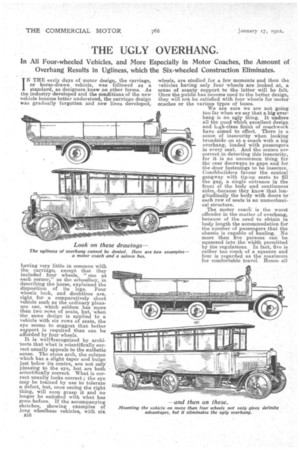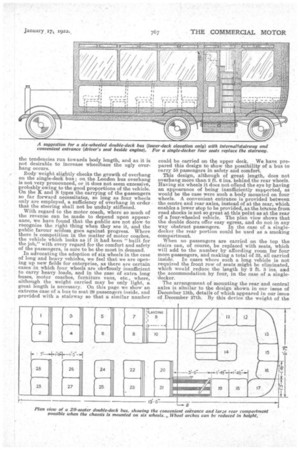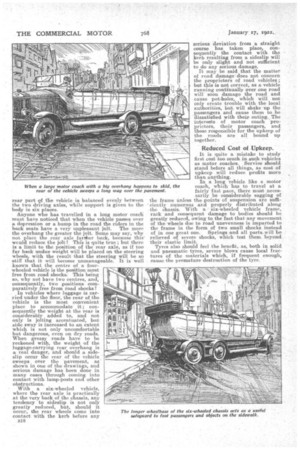THE UGLY OVERHANG.
Page 16

Page 17

Page 18

If you've noticed an error in this article please click here to report it so we can fix it.
In All Four-wheeled Vehicles, and More Especially in Motor Coaches, the Amount of Overhang Results in Ugliness, which the Six-wheeled Construction Eliminates.
IN THE early days of motor design, the carriage, or horse-drawn vehicle, was followed ag a standard, as designers•knew no other forms. As the industry developed and the conditions of the new vehicle became better understood, the carriage design was gradually forgotten and new lines developed,
having very little in common with the carriage, except that they included four wheels, " one at each corner," as the schoolboy, in describing the horse, explained the disposition of its legs. Four wheels look, and doubtless are, right for a comparatively short vehicle such as the ordinary pleasure car, which seldom has more than two rows of seats, but, when the same design is applied to a vehicle with six rows of seats, the eye seems to suggest that better support is required than can be afforded by four wheels.
It is well.recognized by architects that what is scientifically correct usually appeals to the testhetie sense. The stone arch, the column which has a slight taper and bulge just below its centre, are not only pleasing to the eye, but are both scientifically correct. What is correct usually looks correct ; the eye may be trained by use to tolerate a defect, but, once seeing the right thing, will soon grasp it and no longer be satisfied with what has gone before. If the accompanying sketches, showing examples of long wheelbase vehicles, with six
B16
wheels, are studied for a few moments and then the vehicles having only four wheels are looked at, a sense of scanty support to the latter will be felt. Once the public has become used to the better design, they will not be satisfied with four wheels for motor °caches or the various types of buses. We are sure we are not going too far when we say that a big overhang is art ugly thing. It undoes all the good: which excellent design and lugh-class finish of coachwork have aimed to effect. There is a sense of insecurity when looking broadside on at a coach with a big overhang, loaded with passengers in every seat. And the senses are correct in detecting this insecurity, i
for it s no uncommon thing for the rear doorways to gape and for the door fastenings to be insecure. Coachbuilders favour the central gangway with tip-up seats to fill the gap, a single entrance in the front of the body and continuous sides, 'because they know that longitudinally the body with doors to each row of seats is an unmechanical structure.
The motor coach. is the worst offender in the matter of overhang, because of the need to obtain in body length the accommodation for the number of passengers that the chassis is capable of hauling. No more than five persons can be squeezed into the width permitted. by the regulations. In fact, five is examples— rather too much of a squeeze and four is regarded as the maximum for comfortable travel. Hence all
the tendencies run towards body length, and as it is not desirable to increase wheelbase the ugly overhang occurs.
Body weight slightly checks the growth of overhang on the single-deck bus ; on the London bus overhang is not very pronounced, or it does not seem excessive, probably owing to the good proportions of the vehicle. On the K and S types the carrying of the passengers so far forward necessitates, so long as four wheels only are employed, a sufficiency of overhang in order that the steering shall not be unduly stiffened.
With regard to the motor coach, where so much of the revenue can be made to depend upon appearance, we have found that the public are not slow to recognize the right thing when they see it, and the public favour seldom goes against progress. Where there is competition in the matter of motor coaches, the vehicle which looks as if it had been "built for the job," with every regard for the comfort and safety of the passengers, is sure to be the most in demand.
In advocating the adoption of six wheels in the case of long and heavy vehiches, we feel that we are opening up new fields for enterprise, as there are certain cases in which four wheels are obviously insufficient to carry heavy loads, and in the case of extra long buses, motor coaches, furniture vans, etc., where, although the weight carried may be only light, a great length is necessary. On this page we show an extreme case of a bus to seat 29 passengers inside, and provided with a stairway so that a similar number could be carried on the upper deck. We have prepared this design to show the possibility of a bus to carry 58 passengers in safety and comfort. This design, although of great length, does not overhang more than 2 ft. 6 ins, behind the rear wheels. Having six wheels it does not offend the eye by having an appearance of being insufficiently supported, as would be the case were such a body mounted on four wheels. A convenient entrance is provided between the centre and rear axles, instead of at the rear, which enables a lower step to be provided, as the bounce from road shocks is not so great at this point as at the rear of a four-wheeled vehicle. The plan view shows that the double doors offer easy egress, and do not in any way obstruct passengers. In the case of a singledecker the rear portion could be used as a smoking compartment. When no passengers are carried on the top the stairs can, of course, be replaced with seats, which will add to the number by affording room for four more passengers, and making a total of 33, all carried inside. In cases where such a long vehicle is not required the front row of seats might be eliminated, which would reduce the length by 2 ft. 3 ins, and the accommodation by four, in the case of a singledecker.
The arrangement of mounting the rear and central axles is siinilar to the design shown in our issue of December 13th, details of which appeared in our issue of December 27th. By this device the weight of the
rear part of the vehicle is balanced evenly between the two driving axles, while support is given to the body in six places.
Anyone who has travelled in a long motor coach must have noticed that when the vehicle passes over a depression or a bump in the road the riders in the back seats have a very unpleasant jolt. The more the overhang the greater the jolt. Some may say, why not place the rear axle farther back, because this In vehicles where luggage is carried under the floor, the rear of the vehicle is the most convenient place to accommodate it ; consequently the weight at the rear is considerably added to, and not only is jolting accentuated, but side sway is increased to an extent which is not only uncomfortable but dangerous, even on dry roads. When greasy roads have to be reckoned with, the weight of the luggage-carrying rear overhang is a real danger, and should a sideslip occur the rear of the vehicle sweeps over the pavement, as shown in one of the drawings, and serious damage has been done in many oases through coming into contact with lamp-posts and other obstructions.
With a six-wheeled vehicle, where the rear axle is practically at the very back of the chassis, any tendency to sideslip is not only greatly reduced, but, should it occur, the rear wheels come into contact with the kerb before any serious 'deviation from a straight course has taken place, consequently the contact with the kerb resulting from a sideslip will be only slight and not sufficient to do any serious damage. It may be said that the matter of road damage does not concern the proprietors of road vehicles; but this is not correct, as a vehicle running continually over one road will soon damage the road and cause pot-holes which will not only create trouble with the local authorities, but will shake up the passengers and cause them to be dissatisfied with their outing._ The intereets of motor coach proprietors, their passengers, and those responsible for the upkeep of the are all bound up
w
Reduced Cost of Upkeep,
It is quite a mistake to study first cost too much in such vehicles as motor coaches. Service should stand before all things, as cost of upkeep will reduce profits more than anything.
In a long vehicle like a motor coach, which has to travel at a fairly fast pace, there must necessarily be considerable sagging of the frame unless the points of suspension are sufficiently numerous and properly distributed along the chassis. With a six-wheeled vehicle frame, rack and consequent damage to bodies should be greatly reduced, owing to the fact that any movement of the wheels due to road unevenness is imparted to the frame in the form of two small shocks instead of in one great one. Springs and all parts will be relieved of severe shocks, which test them 'beyond their elastic limit.
Tyres also should feel the benefit, as, both in solid and pneumatic tyres, severe blows cause local fractures of the materials which, if frequent enough, cauwe the premature destruction of the tyre.




























